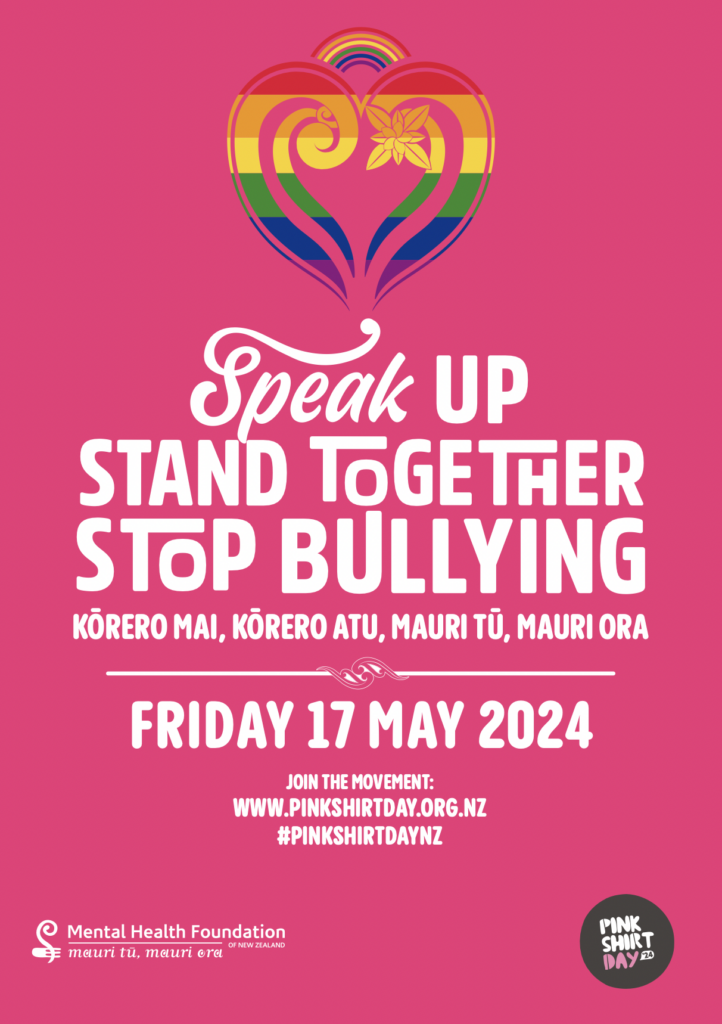Friday was Pink Shirt Day across Aotearoa.
Students and staff at MHJC got involved to spread the message of anti-bullying and acceptance.
We thank everyone who took part! We look forward to 2025!

Friday was Pink Shirt Day across Aotearoa.
Students and staff at MHJC got involved to spread the message of anti-bullying and acceptance.
We thank everyone who took part! We look forward to 2025!

Tomorrow is Pink Shirt Day!
Pink Shirt Day is all about working together to stop bullying and to celebrate diversity in our communities.
Pink Shirt Day is celebrated in Aotearoa and around the world. MHJC will celebrate tomorrow by having students and staff wear pink. We look forward to seeing a sea of PINK tomorrow at MHJC!

| Scientific name | Māori name | Number planted | Description of the plant | Picture |
| Phormium tenax | Harakeke | 4128 | Harakeke is one of New Zealand’s most distinctive native plants. It has long, upright, often stiff leaves which can reach up to 4 metres in length. The black flower stalks can grow up to 5 metres tall and the dull red, nectar-filled flowers attract masses of birds in kōanga/spring, particularly tūī and korimako.Harakeke fibres are used by practitioners of the Māori craft of raranga/weaving to create kete/baskets, whāriki/floor mats and gorgeous kākahu/cloaks as well as taura/ropes. Medicinal properties: Used to stitch or bandage wounds together. The base of leaves were used as a splint for a broken limb. By infusing the roots into an ointment it can treat skin diseases and smallpox. The root also reduces swelling and rashes. | |
| Hebe stricta/Veronica salicifolia | Koromiko | 1712 | One of the most revered medicinal plants in Aotearoa. Provides good low shelter and is an excellent revegetation plant. It has showy white to pale lilac drooping flowers and willow-like foliage. Prefers a moist soil. Koromiko was used extensively by NZ soldiers in WW1 & WW2 to combat diarrhoea. Medicinal properties: The leaves are rich in tannins making them very astringent which aids in curing headaches, dysentery, diarrhoea. The leaves when bruised and applied to treat ulcers, boils and rheumatism. Korom also stimulates appetite. To ease symptoms of diarrhoea, chew the leaf buds or boil them into a tea. | |
| Coprosma repens | Karamū | 1050 | Coprosma Repens is a bushy shrub plant, able to grow up to 6m tall. They have orange berries which are grown during March to July. Their berries are prone to attracting birds and insects. This plant is good for hedges and shelter and coverage as it grows fast. This tree is of high spiritual value to Maori. Used in birthing ceremonies, used before battle to combat evil spirits and to heal the sick. Medicinal properties: Young shoots & leaves were boiled and drunk to heal bladder & kidneys. The vapour from boiled leaves can cure broken bones, cuts, ulcers and eczema. | |
| Coprosma robusta | Glossy karamū | 1050 | Coprosma robusta is a shrub found throughout the North and South Island in New Zealand. It is a mirror-like plant with shiny glossy leaves, leaving shiny reflections. Medicinal properties: As this is in the same family as the coffee plant this can make a strong brew. | |
| Cordyline australis | Tī kōuka | 1860 | Tī kōuka is commonly called a cabbage tree and is one of the most identifiable plants in New Zealand. Planted by Maori to mark paths, boundaries and cemeteries. This plant was a common source of carbohydrates for Maori. To grow, this plant needs an open space without anything overtopping the sun shining on itself. This plant is able to grow in many soils, even in swampy area. It can also grow with three or more of these plants planted together in the same hole. During spring, Tī kōuka produces scented flowers in spring. An important food source for native birds Medicinal properties: It was pounded into a paste. Growing tip (kōata) was eaten raw as a blood tonic or cleanser. Leaves provided juice used externally for cuts, cracks and sores. | |
| Sophora microphylla | Kowhai | 210 | Early Maori used the wood of kowhai for a wide variety of purposes which utilised its durability, elasticity and toughness. It made wedges which were used to split wood: it was used for fences and in whare construction, implements and weapons such as kō, patu, eel spears and taiaha, and carefully selected kowhai roots were used to make large fish hooks.This flowering tree can only grow in the north and east of the north Island, known for its bright yellow colouring flower. The Kowhai flower grows in early spring, attracting birds native birds like tui. Another aspect of the history of kowhai is its use as a garden plant. Because its bright yellow flowers drew the attention of the first visitors to New Zealand, seed was taken to many places in the world. Medicinal properties: Various infusions of kowhai bark (normally taken from the sunny side of the tree) were however used extensively for medicinal purposes, including as a purgative, treatment of scabies, poultices for sprains, bruises, tumours, and wounds, a cure for gonorrhoea and ringworm and relief from colds and sore throats. | |
| Pseudopanax arboreus | Puahou Five Finger | 1500 | Puahou (Five finger) is one of New Zealand’s native trees found in lowland forests. It makes glossy leaves in groups of 5-7 leaves. It grows in many areas, up to 7 m high, producing black berries in autumn. Medicinal properties: Treats eye infections. | |
| Didymocheton spectabilis | Kohekohe | 80 | Kohekohe is also known as Dysoxylum spectabile, is a medium-sized tree native to New Zealand. Kohekohe stands tall symbolising the beauty and resilience of NZ’s native forests. Europeans soon saw that the wood of kohekohe was superb for furniture making; it is after all a member of the same family as mahogany. Unfortunately it does not have the same stability as that timber and its main attribute is the attractive reddish-brown finish. Medicinal properties: Medicinally it was important and was used in various ways; the leaves which contain a bitter component similar to quinine, were used for a range of illnesses including tuberculosis,, coughing, sore throats, boils and women’s disorders. A mixture of kohekohe bark and parts of several other species relieved bleeding and general blood disorders. | |
| Beilschmiedia tarairi | Taraire | 160 | Beilschmiedia taraire also known as Taraire is endemic to the Northern parts of NZ. The species forms the commonest understory species in kauri forest but also is the dominant species in some lowland forests e.g., Kirks’s Bush, Papakura. Taraire is found up to 650 metres but is only abundant below 450 metres. It grows best on well drained, fertile soils and does not tolerate poor drainage or very dry sites. The taraire is known for its impressive size, reaching heights of over 30 metres tall. In the early summer, Taraire produces fruits known as drupes. Medicinal properties: There are no records of the Maori having used taraire for medicinal purposes but the berries were eaten; the kernel after roasting or boiling. | |
| Leptospermum scoparium | Mānuka | 3480 | A distant relative to the Australian Tea Tree. Carries high amounts of oils, hence the attraction for using it as firewood. During the summer, this plant grows white flowers that attract many bees. It is often confused with the plant kanuka, you can tell the difference by feeling the leaves. Manuka leaves are prickly and the kanuka are soft. Medicinal properties: Infusions made with leaves reduce fever & treat urinary and stomach problems. The bark is a sedative. Manuka gum alleviates coughs and is used as a moisturiser for burns. Manuka honey is high in antibiotic properties and rubbed on wounds will heal quickly. | |
| Kunzea ericoides | Kānuka | 1800 | Kanuka is a fast growing tree from the north of the south island to all of the North island. The Maori used kanuka for a wide range of uses, particularly those requiring a hard, strong timber. It was the most favoured wood for the making of agricultural implements –mainly different types of digging sticks. Another important use was for weapons – taiaha, tewhatewha, and koikoi (a double pointed spear).The leaves are softer than manuka and have smaller flowers in the summer. It tolerates droughts, frosts and poor soils. It is fast-growing, but short-lived. Medicinal properties: Medicinally the leaves can be used to make a ”tea” which, when strong, has emetic qualities; when weak it can be a replacement for conventional tea. The shoots and capsules when chewed will relieve dysentery while the inner bark can be boiled and used as a mouthwash and to treat mouth and eye troubles | |
| Dacrycarpus dacrydioides | Kahikatea | 140 | Kahikatea grows throughout New Zealand and is commonest in riverine and swamp forests where it is often found in almost pure stands. Kahikatea is the tallest tree native to NZ reaching up to 60 metres or more. Kahikatea is scientifically known as Dacrycarpus dacrydioides. Its bark is a smooth greyish-brown colour when young. The Tuhoe people reputedly used kahikatea for carving because it carves easily across the grain and holds a sharp edge. But because of its perishable nature no early carvings have survived. In places where totara and kauri were not available it was also used for canoes and soot from burnt wood was used as a tattooing pigment. | |
| Vitex lucens | Pūriri | 80 | Puriri was widely used by Maori in pre-European times. The wood made weapons and implements. It is reputedly the best fence post timber in Aotearoa.Vitex lucens also known as Pūriri. The bark ranges from a reddish-brown colour to grey. In summer and spring pink and white flowers appear, attracting native birds and insects. Medicinal properties: The leaves are used for bathing sprains, backache and ulcers or drunk for sore throats. One of the chemical constituents of the leaves is the methyl ester of p-hydroxybenzoic acid, which has been patented as a germicide. | |
| Knightia excelsa | Rewarewa | 160 | Rewarewa is also known as Knightia excelsa. Rewarewa is a tall straight-trunked tree with vibrant red colours along with glossy green leaves. Rewarewa wood is instantly recognisable because of its pale to dark reddish colour and attractive flecked appearance, often seen in rulers made of inlaid native timber in tourist shops. It is one of only two species in the Protea family in New Zealand; species of which are common in Australia and South Africa. In spring, rewarewa flowers produce abundant nectar which is irresistible to tui and bellbirds and also produces an excellent honey. Medicinal properties: The nectar of rewarewa used to be collected and eaten by Maori who picked the flowers in late spring and tapped them onto the inside of a gourd vessel. The inner bark was bandaged over a wound to stop bleeding and speed its healing. |
References: The meaning of Trees. The history and use of New Zealand’s native plants By Robert Vennell.
Today, a number of MHJC students travelled to St Cuthbert’s College to participate in the annual Lit Quiz.
Our Year 7 team competed against 84 other teams and placed 13th overall! Congratulations to these students on a fantastic day!

𝐌𝐢𝐬𝐬𝐢𝐨𝐧 𝐇𝐞𝐢𝐠𝐡𝐭𝐬 𝐉𝐮𝐧𝐢𝐨𝐫 𝐂𝐨𝐥𝐥𝐞𝐠𝐞 – 𝐀𝐝𝐦𝐢𝐧𝐢𝐬𝐭𝐫𝐚𝐭𝐢𝐨𝐧 𝐉𝐨𝐛 𝐀𝐝𝐯𝐞𝐫𝐭𝐢𝐬𝐞𝐦𝐞𝐧𝐭
Enrolments Processor
Processing of enrolments and reception cover
Part-time: 10 hours per week
Fixed term: 1 year, holidays by negotiation
Flexible times: preferably 2 hours/day
Starting date: negotiable
Remuneration: $27.34/hour
For a job description please see our website.
Cover letter, CV, & support staff application to be emailed to csinclair@mhjc.school.nz
Applications close: 30 May 2024
On Wednesday, MHJC held the annual 𝐓𝐞 𝐌𝐨𝐚𝐧𝐚-𝐍𝐮𝐢-𝐚-𝐊𝐢𝐰𝐚 𝐅𝐞𝐬𝐭𝐢𝐯𝐚𝐥. This festival is a showcase of our Māori and Pasifika cultures and enables students to show who they are to our school and whānau community. The students involved put on incredible performances and we are excited to continue this festival in 2025.

Next week (Week 3 – May 13th-17th), MHJC will be holding our annual 𝐄𝐧𝐯𝐢𝐫𝐨 𝐖𝐞𝐞𝐤.
The week promotes our MHJC philosophy of Kaitiakitanga (Guardianship) of our place, our home, our school, and our land.
Throughout the week, there will be four key activities that support environment initiatives . .
1. Wheels and Walk to School
2. Best /Cleanest Whānau Tautaiao Enviro Cup
3. Tread Lightly Educational lessons for all Year 7 classes
4. Pest Free Howick presentations to all students
An email outlining the above activities has been sent to all students and whānau. Please see this email for more details on how students can participate. We look forward to an exciting week.

Earlier this week, MHJC had teams compete in the South & East Auckland Cluster Chess Tournament.
Our intermediate chess team did extremely well at this tournament and have now qualified for the Auckland Regionals that will be held on August 1st. Other results from the tournament include:
INDIVIDUAL AWARDS
4th place overall (Champions Trophy qualifier) – Japneet Singh (8F1)
3rd place overall (Champions Trophy qualifier) – Vihaan Morem (8M1)
1st place overall (Champions Trophy qualifier) – Ayaan Bhatia (8M1)
TEAM AWARDS
1st place overall 22 points (Auckland Regionals qualifier)

Please see below for some important reminders.
Year 10 NCEA information Evening 6-7pm Tuesday 14th May 2024 – held in the Theatre
Teacher’s Paid Union Meeting – Thursday 16th May 2024
Members of the PPTA (Secondary Teachers Union) will be attending a meeting on Thursday 16th May, 2024. As a result normal classes will stop at 12.00 noon. Please collect your child(ren) @ 12.00 noon from the Valderama Drive entrance only.
The school will remain open with teachers who are not PPTA members supervising students who need to remain at school in their Whānau.
Please email the Whānau Assistant, as below, if you wish your child to be supervised at school from 12pm on Thursday 16th May. For organisational purposes your email should reach us by Thursday 9th May, 2024.
It must be noted that if this request is not received, it is understood that the parent/caregiver will take responsibility for the supervision of their child/ren.
coast-studentservices@mhjc.school.nz
forest-studentservices@mhjc.school.nz
water-studentservices@mhjc.school.nz
mountains-studentservices@mhjc.school.nz